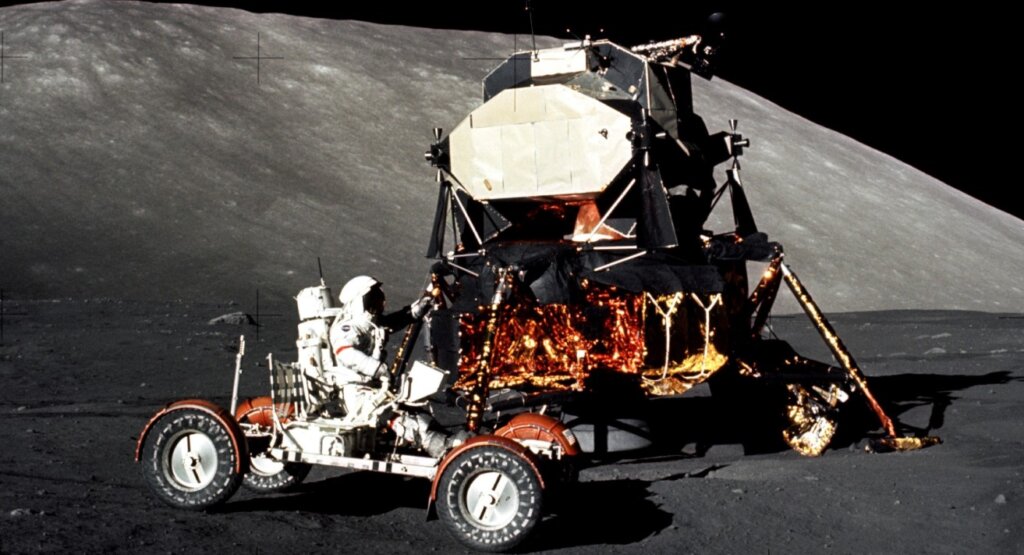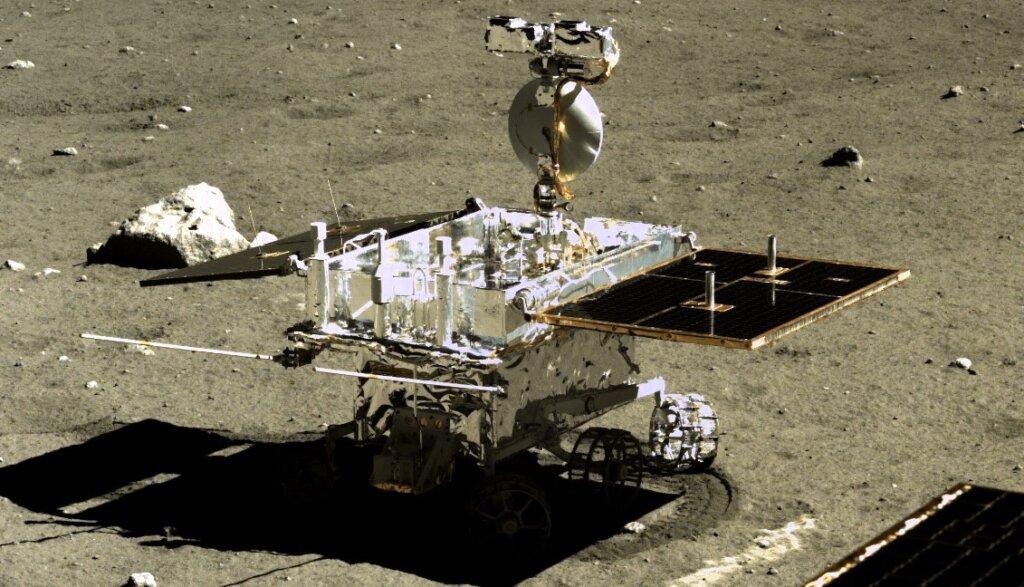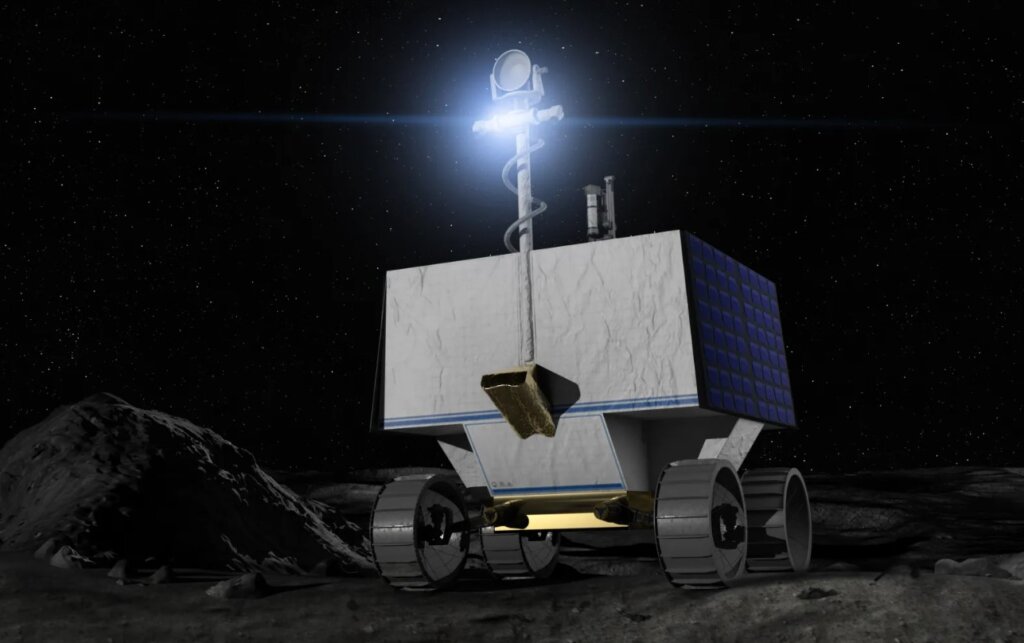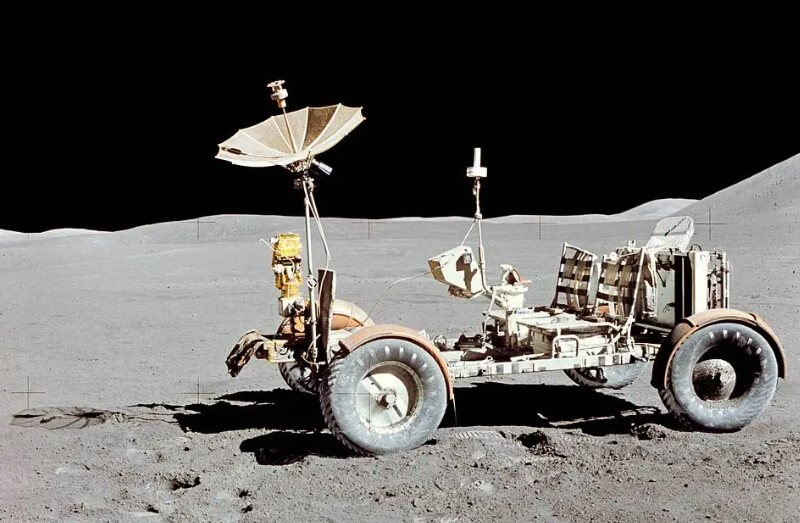The lunar rover is an uncrewed shuttle intended to examine the outer layer of the Moon. A robotic vehicle can move throughout the lunar terrain and gather information about the Moon’s topography, science, and science. Lunar rovers have been deployed on a few missions to the Moon, notably the Apollo missions, the Lunokhod missions, and the Yutu missions.
History of Lunar Rovers
- The Apollo Lunar Roving Vehicle (LRV)
The Apollo Lunar Roving Vehicle (LRV) was a battery-controlled, four wheeled rover employed on the Moon during the last three Apollo missions (Apollo 15, 16, and 17) in 1971 and 1972. It was meant to widen the scope of the space explorers’ workouts on the Moon and to gather testing of lunar rocks and soil.
- History and Development
The advancement of the Lunar Roving Vehicle (LRV) began in 1962, shortly after the primary productive human spaceflight. The Boeing Organization was contracted to plan and manufacture the LRV, and they worked directly with NASA to guarantee that the vehicle solved the space tourists’ requirements.
The LRV was a sophisticated vehicle, and it required quite a long period to plan and manufacture. It was tried broadly under replicated lunar circumstances before it was traveled to the Moon.
- Design
The Lunar Roving Vehicle (LRV) was a lightweight vehicle, weighing just 210 kg (463 lb). This was noteworthy on the basis that the Moon’s gravity is somewhere around one-sixth of Earth’s gravity. The LRV was additionally meant to be not tough to gather and break down so that space travelers might quickly convey it on the Moon.
The Lunar Roving Vehicle (LRV) was powered by two 32-volt batteries, which gave capacity to the vehicle’s motors, steering, and lighting. The batteries could be re-energized by solar panels-based chargers fitted on the vehicle.
The Lunar Roving Vehicle (LRV) could run at a speed of up to 8 miles each hour (13 km/h) and could transfer a cargo of up to 490 kilograms (1,080 lb). This enables space explorers to traverse longer distances and gather a higher number of tests than they could have by walking.
The Lunar Roving Vehicle (LRV) was furnished with different logical instruments, including cameras, a TV transmitter, and a laser rangefinder. This equipment permitted space travelers to concentrate on the Moon’s geography and to acquire information on the lunar climate.
- Operations
The Lunar Roving Vehicle (LRV) was placed on the Moon by the space passengers during their lunar extravehicular exercises (EVAs). The space explorers would drive the LRV to a point of interest, gather tests, and take images. They would then get back to the Lunar Module (LM) with their examples and information.
- Legacy
The Lunar Roving Vehicle (LRV) was bewitching, and it prepared for the improvement of the subsequent lunar rovers. The LRV is still in plain showcase at the Smithsonian National Air and Space Museum in Washington, D.C.
Additional Facts
- The LRV was called “the buggy” by the astronauts.
- The LRV could go for roughly 57 miles (92 km) on a single charge of its batteries.
- The LRV was provided with a covering to shelter the space passengers from the Sun’s radiation.
- The LRV had a steering wheel, joystick, and foot pedals for control.
The Lunokhod Missions: Soviet Moon Rovers

The Soviet Union, in its endeavor to vanquish the Moon, set out on a sequence of aggressive lunar expeditions. Among these, the Lunokhod program stands apart as a display of their design talent and logical interest.
Lunokhod 1: The Trailblazer of Moon Rovers
In 1970, history was created when Lunokhod 1, the first robotic rover to arrive on the Moon, landed on the lunar surface. This spectacular encounter showed a big advance in space sciences.
Lunokhod 1, weighing 1,773 kg (3,913 lb), was a fantastic accomplishment of design. Outfitted with four wheels, it could traverse the rugged lunar landscape at a pace of up to 0.6 miles each hour (1 kilometer each hour). Its eight cameras and two TV transmitters delivered a steady stream of pictures and information back to Earth.
During its 322-day activity, Lunokhod 1 voyaged a great 6,000 meters (3,728 miles), assembling an abundance of logical knowledge. It broke down the lunar soil’s affiliation, centered around the impact of micrometeorites, and perceived the impacts of sun-coordinated radiation.
Lunokhod 2: Growing the Frontiers of Lunar Exploration
In 1973, expanding on the outcome of Lunokhod 1, the Soviet Union launched Lunokhod 2, an upgraded form of its ancestor. This most recent moon rover delivered a more refined clever payload, including a laser-going gadget, a general camera, and a dirt mechanics penetrometer.
Lunokhod 2 arrived in the lunar highlands, a site with a complex topographical history. Over its 45-day functional time, it covered 37 kilometers (23 miles), directing many logical examinations.
It concentrated on the lunar surface’s material mix, explored the dirt’s mechanical qualities, and focused on the lunar night sky.
Lunokhod 2’s liabilities to the lunar review were substantial, supplying bits of knowledge about the Moon’s property development, and it evaluated the end for future human solicitations.
The Legacy of Lunokhod
The Lunokhod flights addressed a critical period in time in lunar review. These independent meanderers found the plausibility and reasonableness of mechanical demands and made plans for future lunar missions by NASA, China, and other space organizations.
The material given by Lunokhod 1 and Lunokhod 2 continues to be regarded and studied, discovering major pieces of knowledge about the Moon’s broadness of experiences, affiliations, and possibilities for future human requests. Their heap of encounters expands, forcing persons accessible for experts and originators to look at the purposes of space exploration.
- Venturing into the Unknown Unveiling the Moon’s mystifications with China’s Yutu operations
In the circle of space exploration, China has cultivated a circus may, offering aggressive operations to uncover the secrets of the macrocosm. Among this enterprise, the Yutu lunar rover operations crop as a demonstration of their mechanical degrees of enhancement and constant bourses.
Yutu- 1 Leading China’s Lunar Exploration

In 2013, China made its appearance in lunar rover operations with the launch of Yutu-1, occasionally dubbed Jade Rabbit. This robotic rover, transmitted by the Chang’e 3 lunar lander, came down on the Mare Imbrium, a large lunar plain.
Yutu-1, importing 140 kg (309 lb.), was supposed to cross the Moon’s face, directing an expansive logical analysis. Accoutered with wide cameras, a ray rangefinder, and an alpha-proton x-ray support spectrometer, it acquired essential information on the Moon’s area, wisdom, and terrain.
During its 31 lunar long ages of operation, Yutu-1 voyaged a remarkable 114 kilometers (71 long hauls), outperforming the distance traveled by its Soviet fathers. It delved into the lunar soil’s format, zeroing concentrated on the distribution of lunar boulders, and exploring the impacts of space radiation.
Yutu-1’s achievement indicated an outstanding accomplishment in China’s lunar inquiry program, preparing for unborn operations and putting forward China as a central element of space disquisition.
Yutu- 2 Unveiling the Secrets of the Descartes Mounds
In 2016, China blasted off Yutu- 2, an enhanced interpretation of its ancestor, to probe the Moon’s Descartes mounds. This rough terrain, with its varied topographical conformations, offers another frontier for scientific inquiry.
Yutu-2, importing 210 kg (463 lb.), transported an altered scientific cargo, including a noteworthy and close infrared spectrometer, a land radar, and a neutron locator. These instruments permitted it to direct a more detailed exploration of the lunar soil’s association, concentrate on the movement of lunar coffers, and test the subterranean construction of the Moon.
As Yutu-2 proceeds with its passage over the Moon, it has proactively made crucial exposures, flashing back the position of water ice for the for all time shadowed sections of the Moon. This result has enormous impacts on unborn mortal disquisition and the possibility of resource exploitation on the Moon.
The Enduring Legacy of Yutu
China’s Yutu operations have disintegrated lunar disquisition, displaying the remarkable powers of robotic rovers in disentangling the secrets of the Moon. These operations have enlarged how we might view the Moon’s geographical history, its conflation, and its true capacity for unborn mortal disquisition.
The Yutu operations stand as evidence of China’s rising conspicuousness in the global space field, stirring people in the future of scientists and masterminds to push the borders of knowledge and disquisition. As Yutu-2 proceeds with its passage across the lunar scene, we anxiously anticipate the ensuing stage of China’s lunar study attempts.
- VIPER: Unveiling the Secrets of the Moon’s Icy Poles
The Volatiles Researching Polar Investigation Meanderer (VIPER), a NASA-drove mission in collaboration with the Canadian Space Agency (CSA), is planned to go on a major journey to the Moon’s South Pole in 2023. This mechanical lunar rover is meant to chase after water ice and different volatiles, giving basic encounters into the moon’s progression and the prospects for future human research.
The Mission for Water Ice

The occurrence of water ice on the Moon has for some time been a matter of rational dispute. Proof from prior expeditions, including the placement of hydrogen markings in all-time shadowed regions, indicates that water ice could exist here. VIPER’s fundamental purpose is to set out the existence of water ice and make sense of its flow, flood, and accessibility.
VIPER’s Scientific Instruments
To fulfill its key aim goals, VIPER is supplied with a set-up of improved logical tools, including:
The Near-Infrared Volatiles Spectrometer (NIR-VSS): This instrument will plan the appropriation of water ice and other volatiles over the Moon’s South Pole.
The Drill for Obtaining Ice Samples (DOIS): This drill will extract central specimens of lunar regolith, letting researchers analyze the synthesis and design of the ice reserves.
The Mass Spectrometer for Surface and Space Exploration (MASSE): This device will dissect the structure of gases released free from the regolith, delivering experience into the unstable stock of the Moon.
The Solar Volatile Investigation of Polar Exploration Rover (SVIPE): This sensor will quantify the temperature and piece of the lunar surface, aiding with studying the cycles that govern the appropriation and dependability of water ice.
VIPER’s Investigation Methodology
VIPER will explore the Moon’s South Pole, zeroing in on persistently shadowed areas (PSRs) and regions with high concentrations of hydrogen. These PSRs are seen as good sites for water ice protection because of the absence of direct sunshine, which may sublimate and disintegrate the ice.
VIPER will systematically tour the lunar terrain, employing its NIR-VSS equipment to plan the circulation of water ice. When a region of interest is recognized, VIPER will deploy its DOIS drill to remove central specimens of the regolith. These samples will then be broken down by MASSE and SVIPE to assess their structure and potential for future asset utilization.
VIPER’s Effect on Lunar Exploration
The VIPER mission is meant to make substantial commitments to how we could understand the Moon’s collection of experiences, its actual capability for future human exploration, and the hunt for life past Earth. By verifying the occurrence of water ice and presenting its spread, VIPER will make ready for the enhancement of economical lunar communities and the possibility for in-situ resource use (ISRU).
In addition, the disclosure of water ice on the Moon might have ideas for the hunt for life past Earth. Water is necessary for life as far as humans are concerned, and its existence on the Moon would boost the possibility of tracking down life someplace else in the surrounding planet group.
- The Eventual Fate of Lunar Rovers: Investigating the Moon and Beyond
Lunar rovers, mechanical vehicles meant to travel the Moon’s surface, have a major role in lunar study. From the Apollo Lunar Roving Vehicle (LRV) of the 1970s to the Yutu rovers of China’s Chang’e missions, these adaptive vehicles have given researchers substantial knowledge of the Moon’s topography, science, and potential for asset usage.
Advancing Lunar Rover Capabilities
As we look towards the fate of lunar exploration, lunar wanderers are ready to turn out to be substantially more sophisticated and skilled. Specialists and architects are consistently growing new enhancements to boost the presentation and abilities of these autos.
Increased Autonomy and Intelligence
Future moon rovers will integrate advanced artificial intelligence (AI) and machine learning algorithms to empower more noteworthy independence and understanding. These rovers will truly wish to explore complicated terrain, pursue decisions autonomously, and react to changing situations without regular human involvement.
Upgraded Portability and Versatility
New designs and inventive movement frameworks will boost the adaptability of future lunar rovers. These rovers anticipate traversing more outrageous slopes, going over obstructions, and exploring unmistakable lunar panoramas. Additionally, they will be supplied with adaptable structures that can conform to shifting regular settings, such as insane temperatures and radiation transparency.
Extended Scientific Instrumentation
Future lunar proofs will transmit a more thorough set-up of logical equipment, contemplating a more extended scope of investigations. These devices will desire to execute in-situ examinations of lunar rocks and soil, pinpoint modest variations in the lunar environment, and perhaps hunt for indicators of past or current life.
Resource Utilization and Exploration
Lunar rovers will be vital in detecting and extracting lunar resources, for example, water ice, minerals, and metals. These resources may be exploited for future human settlements, in-situ gathering, and planned refueling stations for space exploration.
Preparing for Human Exploration
Lunar rovers will prepare for future human expeditions to the Moon. They will be employed to survey probable landing locations, plot out itineraries for human transit, and conduct experiments that will identify future human homes.
International Collaboration and Partnerships
The turn of events and dispatching of future lunar rovers will certainly require worldwide cooperative efforts and alliances. Space workplaces from one side of the globe to the other are little by bit connected with trade resources, talents, and development to enhance lunar exploration.
- Conclusion
Lunar rovers are preparing to play a more unmistakable function in future lunar exploration. As these vehicles get more current and fit, they will open new boundaries of logical revelation, make ready for asset utilization, and plan for the following time of human existence on the Moon. The fate of lunar rovers is bright, and their commitments to how we may understand the Moon and the possibility of space exploration are endless.
